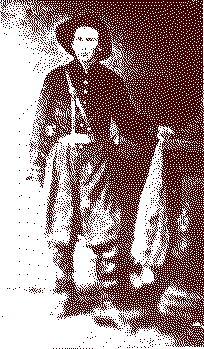WAKEFIELD
|
Missouri guerrilla chief William Quantrill remained largely inactive through most of 1864. Some say he lost his position of leadership to former lieutenants William Anderson and George Todd and decided to take leave of the war, camping out with his young wife, Kate, in Howard County. But by the end of the year he joined several of the old members of his band and left Missouri for Kentucky. It is unclear why Quantrill chose to go to Kentucky at this time. One early theory suggested he was heading east to assassinate President Lincoln. Some say he wished to acquire leadership of a new guerilla band. Some say he foresaw the end of the war and wished to surrender at the military garrison in Louisville, knowing he could never surrender safely in Missouri. Whatever the reason, he and his band got as far as Spencer County in north central Kentucky where, on May 10, 1865, they were hiding in a barn belonging to a Confederate sympathizer named James Wakefield. Quantrill was taking a nap in the hayloft when one of his men suddenly cried out an alarm as a group of Union guerrillas led by Capt. Edwin Terrell descended upon them. Quantrill was mortally wounded, some say by a man named John Langford, as he was attempting to mount a horse to escape. Paralyzed from the waist down, he was carried to the Wakefield home. A few days later Terrell took him by wagon to Louisville where Quantrill died on June 6, 1865. Terrell was briefly considered a hero by the national press for his part in killing Quantrill, but many Kentuckians were far from enamored with him. Ed's own sister Alice is reported to have declared she would never marry until she received word of Ed's death. Terrell was in the Confederate army for a brief time, but was imprisoned and sentenced to be executed for killing a superior officer. Before the execution he escaped and promptly joined the Union Army. Eventually he was made captain of the Shelby County Home Guards, whose main mission was to kill Confederate guerrillas. During this time Terrell became known as a fearless fighter with enormous confidence and bravado, said by some to dress in bright red colors from head to toe. He also became known as a bully, a thief and a murderer of civilians, be they Union or Confederate in sympathy. Ironically, Terrell, like Quantrill, was ambushed, paralyzed by one of the bullets and taken to Louisville where he died a year after Quantrill died. His obituary in the Louisville Journal (May 27, 1866) states: “No man ever more richly deserved a torturous death.”
|
